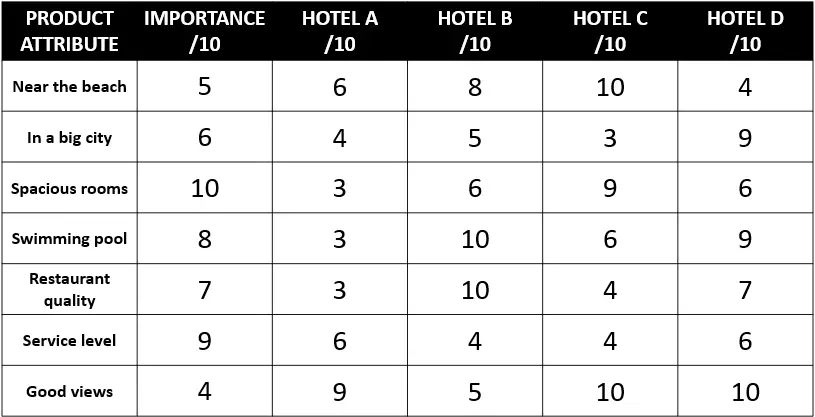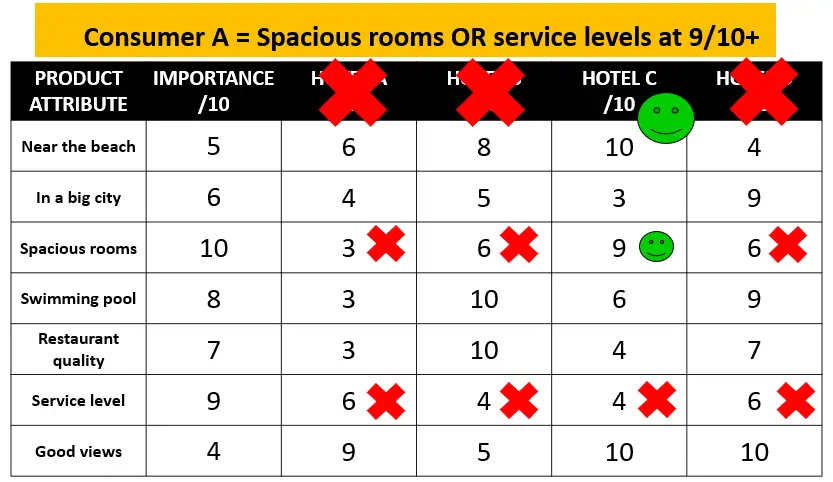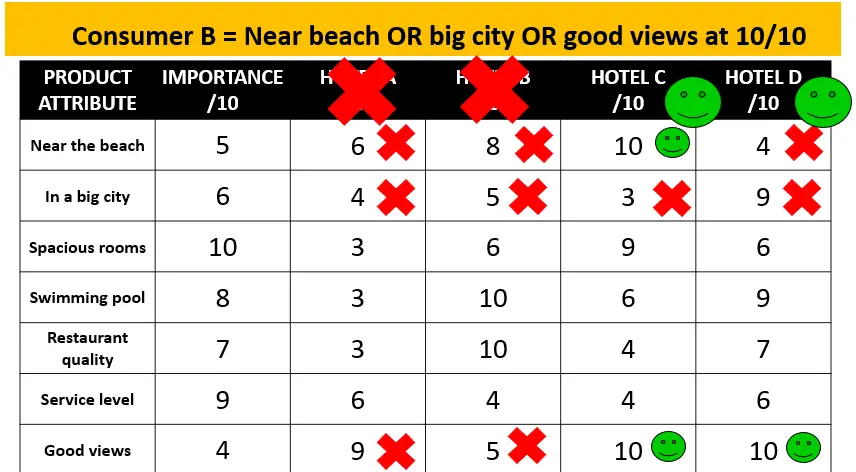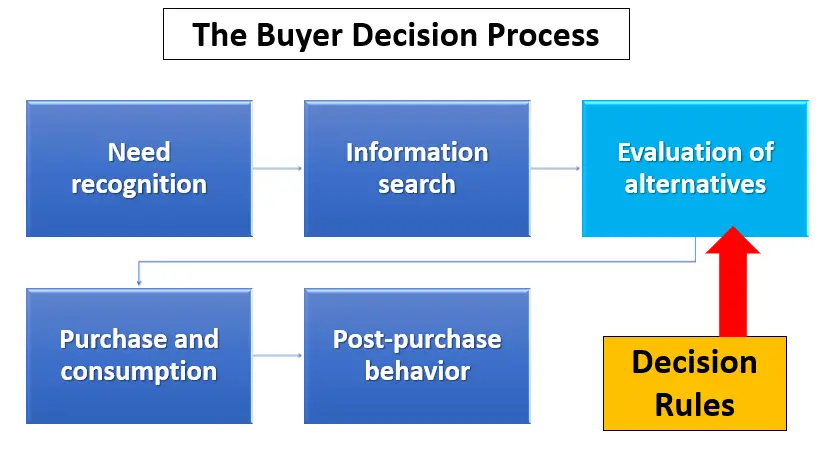Contents
What is the Disjunctive Decision Rule in Consumer Behavior?
Covered in this article:
- Overview of the Disjunctive Decision Rule
- How to Recall the Disjunctive Rule
- A Worked Example of the Disjunctive Decision Rule
- Why Consumers Would Use the Disjunctive Rule
- How Disjunctive Rule differs from other Decision Rules
- A Video Summary of the Disjunctive Rule
- The Main Types of Decision Rules Used by Consumers
- Where Decision Rules Fit into Consumer Behavior
Overview of the Disjunctive Decision Rule
The disjunctive decision rule is a non-compensatory approach to decision-making for consumers.
It is similar to other non-compensatory decision rules in that it considers selected product attributes that are important to the consumer.
However, it differs because, with this rule, the consumer is willing to trade-off attributes. That means they are looking for a product that is great in either product attribute A OR great in product attribute B (and potentially other attributes as well).
For example, if the consumer was looking to buy a smart TV, then they may want to only consider that the product offerings that have:
- a very large screen OR
- have an amazing picture quality
In this case, the consumer has selected two independent product attributes and are willing to purchase (or consider) any product that is great on a single (and very important to them) product attribute.
How to Recall the Disjunctive Rule
A simple way to recall the disjunctive rule is to rely upon the first part of the word, that being “dis”. We can then associate “dis” with either disconnected or disjointed.
In either regard, the disconnection refers to the approach where the product attributes are not interrelated but are treated independently by the consumer.
Therefore, in the consumer’s mind, there is a disconnect between the attributes and they are NOT considering a set or package of combined attributes.
A Worked Example of the Disjunctive Decision Rule
Let’s work through the disjunctive decision-making approach using an example. For this example, we are going to select between four competing hotels for a holiday.
The following table summarizes the consumer’s assessment of these hotels. As you can see, in the left-hand column is a list of product attributes.
And as we move across the table, we can see that each attribute for each hotel has been scored out of 10 – with higher scores representing greater quality or performance as perceived by the consumer.
Let’s now see how two different consumers would implement the disjunctive rule and what hotel they would select as a result.
Let’s assume that Consumer A wants a score of 9/10 or more for:
- spacious rooms OR service levels.
And that Consumer B wants a score of 10/10 or more for:
- near the beach OR in a big city OR good views.
As we can see, although both consumers are using the same decision rule, they have structured it according to their needs and preferences. This way two consumers using the same approach to decision-making are likely to have different purchase outcomes.
Consumer A
As we can see in the following table – where the smiley face means that the attribute meets their requirements of 9/10 and the cross means that it fails to meet that required quality/performance.
In this case the consumer would select Hotel C because it has met their requirements for spacious rooms. The other three hotels all ruled out because they do not meet consumers minimum expectation for either spacious rooms or service levels.
In other words, Hotel C is the only acceptable solution (product choice) for the consumer based upon how they have implemented the disjunctive rule.
We have a similar table for the second consumer below. Remember that they are considering three attributes but have a different score/expectation.
In this case we have two suitable hotels that the consumer will now consider. Hotel C has met their requirements for both “near the beach” and “good views”.
And Hotel D has also met their requirement for “good views”.
Please note that when using the disjunctive rule, it does not matter how many product attributes are acceptable for the consumer. There only needs to be ONE attribute that means their requirements for it to be further considered.
In this case, Consumer B will now need to implement a second decision rule (or modify their approach to the disjunctive rule) to make a final purchase decision.
Note: Conjunctive and Disjunctive Decision Rules may not provide a Single Product Choice Outcome
As we have demonstrated above with Consumer B, the use of the disjunctive rule resulted in two possible alternatives being left in the decision. This situation can also occur with the conjunctive decision rule.
While this is not ideal, these two rules are usually considered to be more effective for shortlisting a lot of brands and product choices and then will be followed by the use of a second decision rule focused on the shortlisted options only.
Why Consumers Would Use the Disjunctive Rule
This decision rule would be used if the consumer:
- Was looking to short-list a very large set of potential products option quickly, with the intention of using a second decision rule
- Did not believe that that was a single product solution that was likely to meet all of their requirements
- It is in the early stage of their decision where they are uncertain of the precise product attribute/s that will form the basis of their final choice
- They are willing to trade-off attributes, as they do not perceive attributes being interrelated in the product design
- And potentially they have budget constraints and cannot afford a product solution that offers superior quality across multiple product attributes
How does the Disjunctive Decision Rule differ from other Decision Rules
In some regards, this approach decision-making is almost the opposite to the conjunctive rule. When using the conjunctive rule, consumers will seek a combination of attributes and will only consider product options that can meet their requirements for a set of attributes.
This is distinctive from the disjunctive rule where a product that is strong on a single attribute will be considered.
The disjunctive rule is also quite different from the compensatory decision-making approach, which considers the overall product offering by looking at multiple product attributes.
It does not rely upon a single attribute, regardless of the strength – but instead looks at the overall strength of the attributes combined.
However, there is an overlap with both the lexicographic and elimination-by-aspects decision rules.
The lexicographic rule will seek out ONE product attribute (the most important one) to drive the decision. Therefore, the lexicographic approach and a disjunctive approach could result in the same purchase decision.
Likewise, the elimination-by-aspects decision rule works from the most important attribute downwards and eliminates underperforming products on a per attribute basis.
It is possible that the elimination-by-aspects decision rule will result in a similar product purchase decision as the disjunctive rule when it is combined with a second decision rule.
A Video Summary of the Disjunctive Rule
The following video provides a summary of this decision rule:
The Main Types of Decision Rules Used by Consumers
The main decision rules that are covered in most consumer behavior textbooks are listed as:
- Compensatory decision-making and
- Non-compensatory decision rules, which include:
- conjunctive,
- disjunctive,
- elimination-by-aspects,
- lexicographic, and
affect referral
The following video provides a brief overview of each of these decision rules.
Where Decision Rules Fit into Consumer Behavior
Decision rules are used by consumers in the evaluation of alternatives stage of the buyer decision process – as shown in the following diagram. At this point in the process, they have gathered information and now must make a selection from competing alternatives.
Related Articles
- What is the compensatory decision-making approach?
- What is the conjunctive decision rule?
- What is the elimination-by-aspects decision rule?
- What is the lexicographic decision rule?
- What is the affect referral decision rule?




